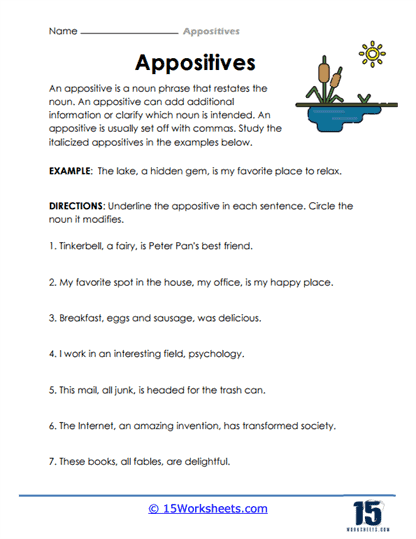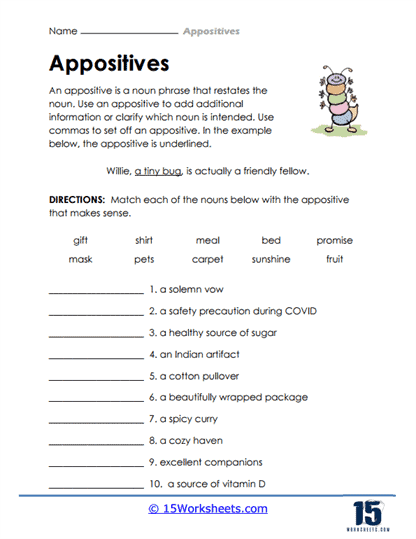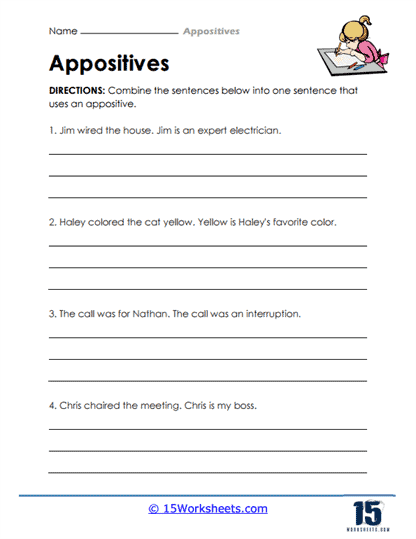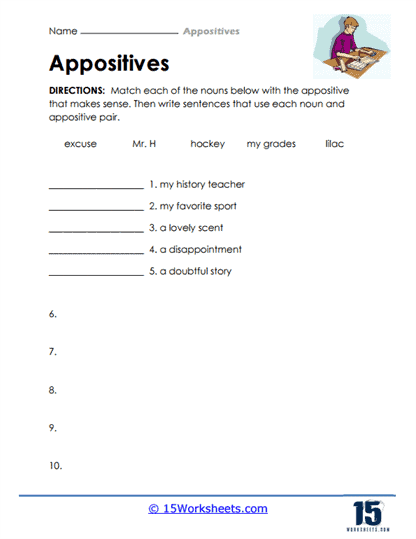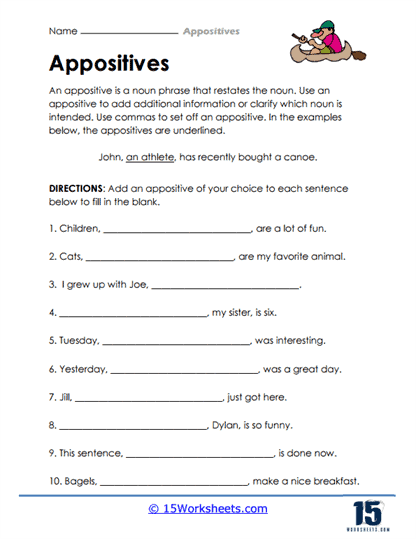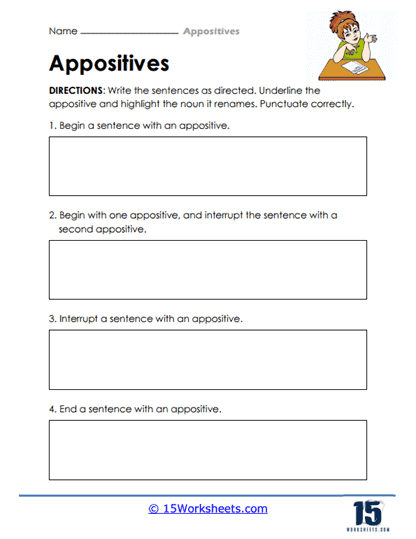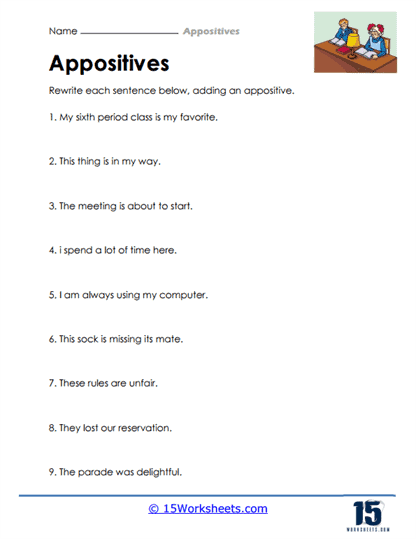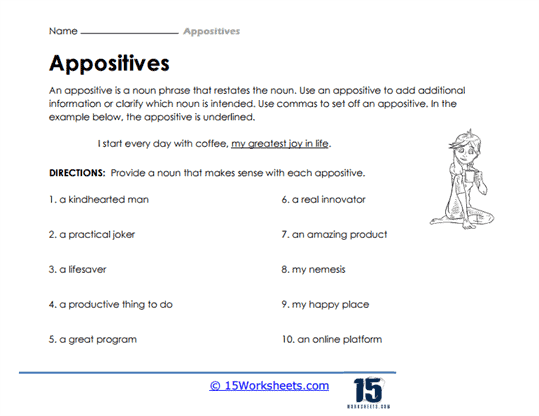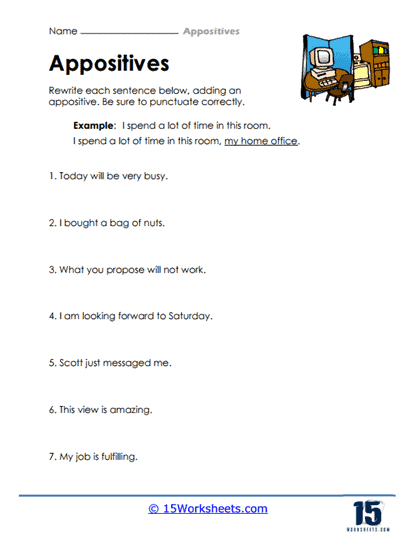Appositives Worksheets
All About These 15 Worksheets
These thoughtfully crafted appositives worksheets are designed to help students develop a deep and practical understanding of how appositives function in grammar. Appositives are noun phrases that rename or further explain another noun or pronoun in a sentence, offering a powerful way to add detail and clarity. By guiding students through both the structure and stylistic potential of appositives, these worksheets aim to strengthen not only grammatical accuracy but also overall writing fluency.
The worksheets begin with a clear introduction to what appositives are, complete with definitions and illustrative examples. Students learn to recognize how appositives give extra information-like renaming a subject or adding context-without creating entirely new sentences. Through practice identifying appositives and the nouns they modify, students sharpen their reading comprehension and develop a more nuanced understanding of sentence structure.
As students move through the worksheets, they’ll complete exercises that involve adding appositives to existing sentences, combining two sentences using appositives, and revising sentences to make them more descriptive. These activities encourage learners to actively experiment with language, learning how appositives can enrich a sentence without being repetitive. By crafting their own sentences and even full paragraphs with appositives, students practice creative expression and learn to control tone and style with greater precision.
By the end of these worksheets, students will have achieved several important skills:
Identify appositives and their functions – Students will be able to spot appositives in a sentence and correctly identify the nouns they clarify or rename, which builds grammatical awareness.
Add appropriate appositives to sentences – They’ll learn to enrich basic sentences with well-placed appositives, improving their ability to write with detail and depth.
Compose well-structured paragraphs using appositives – By using appositives consistently throughout a piece of writing, students will build stronger, more engaging paragraphs.
Understand appositive placement – Students will practice placing appositives at the beginning, middle, or end of a sentence-learning how placement affects flow and emphasis.
Use correct punctuation with appositives – Most importantly, they’ll gain confidence in punctuating appositives correctly, a key skill for clean and professional writing.
In short, these appositive worksheets are more than just a grammar drill-they’re a bridge to better writing. By learning how to use appositives effectively, students will be equipped to write with more precision, variety, and voice. Whether they’re drafting an essay, telling a story, or composing an informative paragraph, the ability to use appositives well will enhance the clarity and richness of their writing.
What are Appositives?
Appositives are noun phrases that provide additional information about another noun or pronoun in a sentence. They are often placed next to the noun or pronoun they are describing and are separated by commas.
Appositives can be used to rename or clarify a noun or pronoun, or to add descriptive information to a sentence. Here are some examples:
- My friend, a talented musician, played the guitar at the party. (The appositive “a talented musician” renames “my friend” and provides additional information about their skills.)
- The insect, a butterfly, landed on the flower. (The appositive “a butterfly” adds descriptive information about the insect.)
- My favorite fruit, mangoes, are in season. (The appositive “mangoes” clarifies which fruit the speaker is referring to and provides additional information about their preference.)
Appositives can also be used to combine sentences by replacing a noun or pronoun with an appositive. For example:
- The teacher was angry. She yelled at the class.
- The teacher, angry, yelled at the class.
- My cat is black. Her fur is shiny.
- My cat, whose fur is shiny, is black.
Appositives can add clarity and detail to writing, making it more descriptive and engaging. However, it is important to use them correctly and to place them in the right position in the sentence to avoid confusion or ambiguity.
Why do students need to learn all about Appositives?
Understanding and using appositives is a powerful way for students to strengthen their writing. Appositives-those little noun phrases that rename or explain another noun-might seem like small grammatical tools, but they pack a big punch when it comes to improving clarity, flow, and precision. These worksheets not only teach students how appositives work but also guide them through applying this knowledge in real writing situations. Mastering appositives equips students with several key writing skills that are essential for academic and personal communication.
Students will learn how to add meaningful detail to their writing by using appositives. Rather than relying on additional sentences or vague descriptions, an appositive allows a writer to insert important information directly into a sentence. For example, “My teacher, Mrs. Adams, gave us homework” is far more informative than simply “My teacher gave us homework.” Through practice, students will gain confidence in using appositives to make their writing more descriptive and helpful to readers, giving context without overcomplicating their sentences.
Students will understand how appositives can combine ideas and reduce redundancy, making their writing cleaner and more concise. Instead of writing two separate sentences-“My brother is an engineer. He works in robotics.”-a student can write, “My brother, an engineer, works in robotics.” This not only tightens the sentence but also keeps the reader engaged. Students will explore how appositives can improve the efficiency of their writing without sacrificing meaning or detail.
Students will also learn how appositives eliminate confusion and add clarity, especially when a noun might be unclear or generic. For instance, in a sentence like “Sarah gave the book to her friend,” the reader might wonder who the friend is. But with an appositive-“Sarah gave the book to her friend, Emily”-the sentence becomes instantly clearer. By practicing with appositives, students learn how to make their writing more precise, avoiding ambiguity and ensuring the reader always understands exactly who or what is being referenced.
Finally, the use of appositives demands a solid grasp of grammar and punctuation rules, especially when it comes to commas. Knowing when to use commas (e.g., with nonessential appositives) versus when to leave them out (with essential appositives) gives students deeper insight into sentence structure. This kind of grammatical awareness translates into stronger writing across the board, building the foundational skills students need for essays, reports, and even creative storytelling.
In short, learning about appositives helps students move from writing that is technically correct to writing that is thoughtful, refined, and impactful. They’ll come away from these lessons with greater control over their language, the ability to communicate ideas with clarity, and the confidence to add style and substance to their writing. Whether they’re preparing for academic success or future professional writing, appositives are a small detail that make a big difference.


